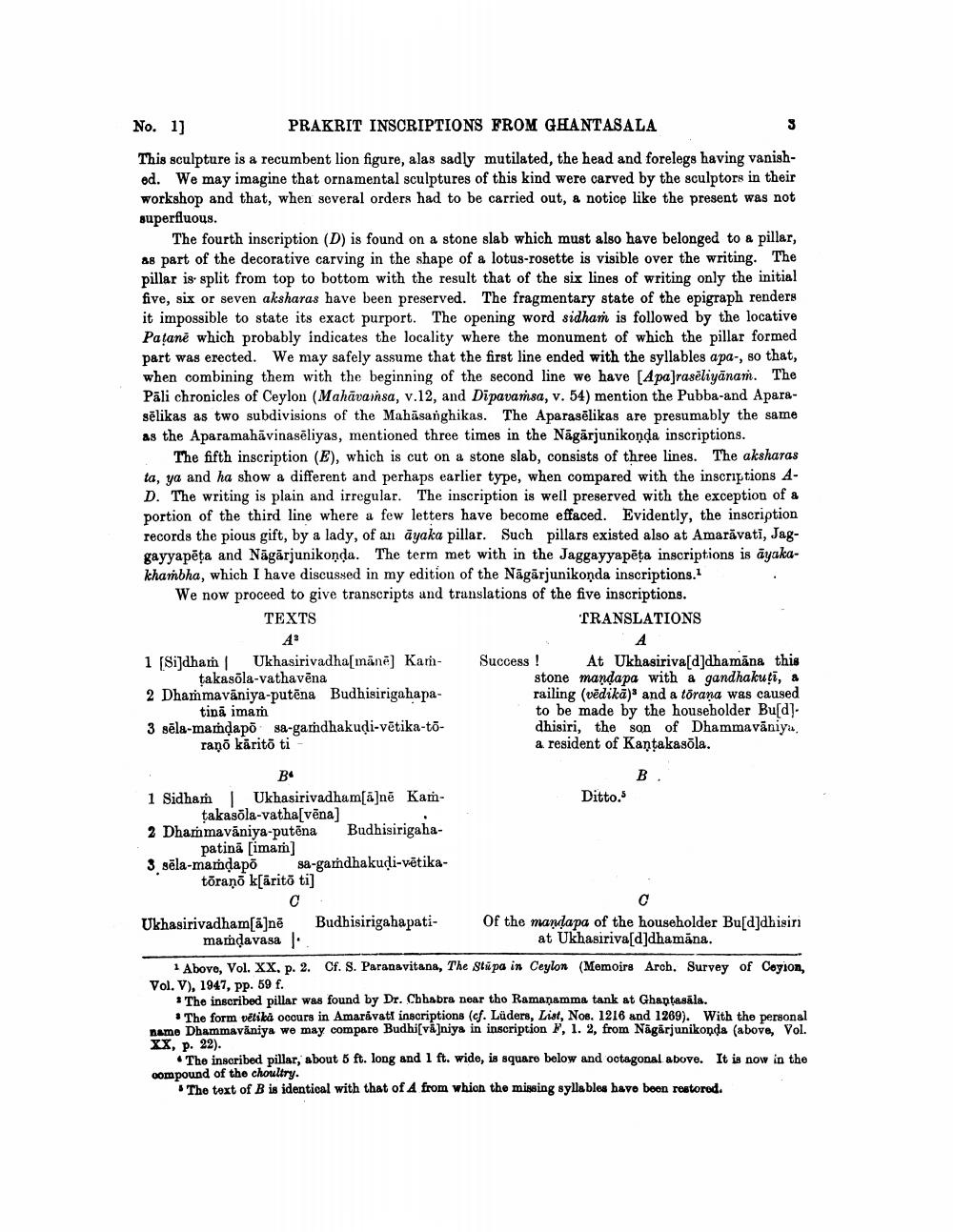________________
No. 1]
PRAKRIT INSCRIPTIONS FROM GHANTASALA This sculpture is a recumbent lion figure, alas sadly mutilated, the head and forelegs having vanished. We may imagine that ornamental sculptures of this kind were carved by the sculptors in their workshop and that, when several orders had to be carried out, a notice like the present was not superfluous.
The fourth inscription (D) is found on a stone slab which must also have belonged to a pillar, as part of the decorative carving in the shape of a lotus-rosette is visible over the writing. The pillar is split from top to bottom with the result that of the six lines of writing only the initial five, six or seven aksharas have been preserved. The fragmentary state of the epigraph renders it impossible to state its exact purport. The opening word sidhan is followed by the locative Patanē which probably indicates the locality where the monument of which the pillar formed part was erected. We may safely assume that the first line ended with the syllables apa-, so that, when combining them with the beginning of the second line we have [A pajrasëliyānam. The Pāli chronicles of Ceylon (Mahavainsa, v.12, and Dipavamsa, v. 54) mention the Pubba-and Aparasēlikas as two subdivisions of the Mahāsanghikas. The Aparasēlikas are presumably the same as the Aparamahāvinasēliyas, mentioned three times in the Nāgārjunikonda inscriptions.
The fifth inscription (E), which is cut on a stone slab, consists of three lines. The aksharas ta, ya and ha show a different and perhaps earlier type, when compared with the inscriptions AD. The writing is plain and irregular. The inscription is well preserved with the exception of a portion of the third line where a few letters have become effaced. Evidently, the inscription records the pious gift, by a lady, of an ayaka pillar. Such pillars existed also at Amaravati, Jaggayyapēta and Nagarjunikonda. The term met with in the Jaggayyapēta inscriptions is āyakakhambha, which I have discussed in my edition of the Nāgārjunikonda inscriptions. We now proceed to give transcripts and translations of the five inscriptions. TEXTS
TRANSLATIONS
1 (Sildham Ukhasirivadha[mānē] Kam-
takasõla-vathavēna 2 Dhammavāniya-putēna Budhisirigahapa
tină imam 3 sēla-mamdapo sa-gamdhakudi-vētika-to
raņā kärito ti
Success! At Ukhasiriva[d]dhamāna this
stone mandapa with a gandhakuti, a railing (vēdikā) and a törana was caused to be made by the householder Bu[d] dhisiri, the son of Dhammavāniya. a resident of Kantakasõla.
B
B.
Ditto.5
1 Sidham Ukhasirivadham[ā]nē Kam
takasõla-vatha[vēna) 2 Dhammavāniya-putēna Budhisirigaha
patină (imam] 3 sëla-mandapo sa-gandhakuļi-vētika
tõraņā k[ärito ti]
o
Ukhasirivadham[äjnë Budhisirigahapati- Of the manapa of the householder Bu[d]dhisini mamdavasal
at Ukhasiriva[d]dhamāna. 1 Above, Vol. XX. p. 2. Cf. S. Paranavitana, The Stüpa in Ceylon (Memoirs Arch. Survey of Coyion, Vol. V), 1947, pp. 59 f.
: The inscribed pillar was found by Dr. Chhabra near tho Ramanamma tank at Ghantasala.
• The form vētikà occurs in Amaravati inscriptions (cf. Lüders, List, Nos. 1216 and 1269). With the personal name Dhammavaniya we may compare Budhi[vājniya in inscription , 1. 2, from Nagarjunikonda (above, Vol. XX, p. 22).
• The inscribed pillar, about 5 ft. long and 1 ft. wide, is square below and octagonal above. It is now in the compound of the choultry.
The text of B is identical with that of A from whion the missing syllables have been restored.




